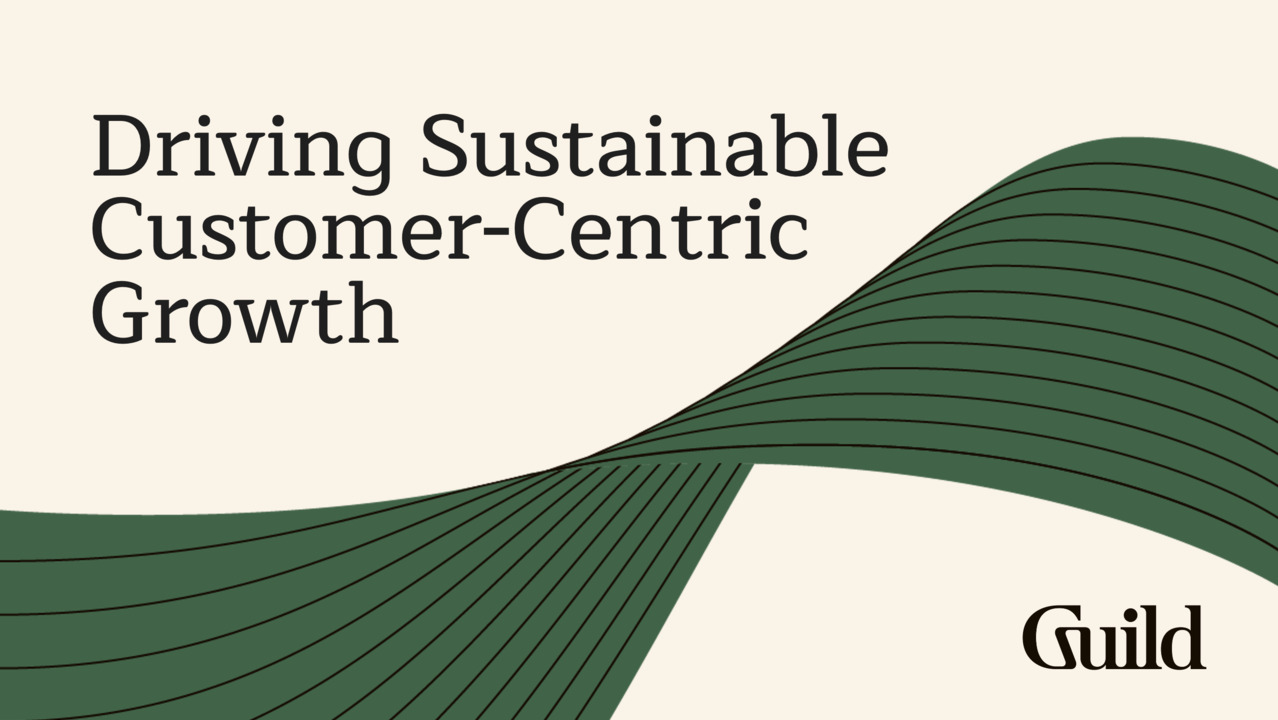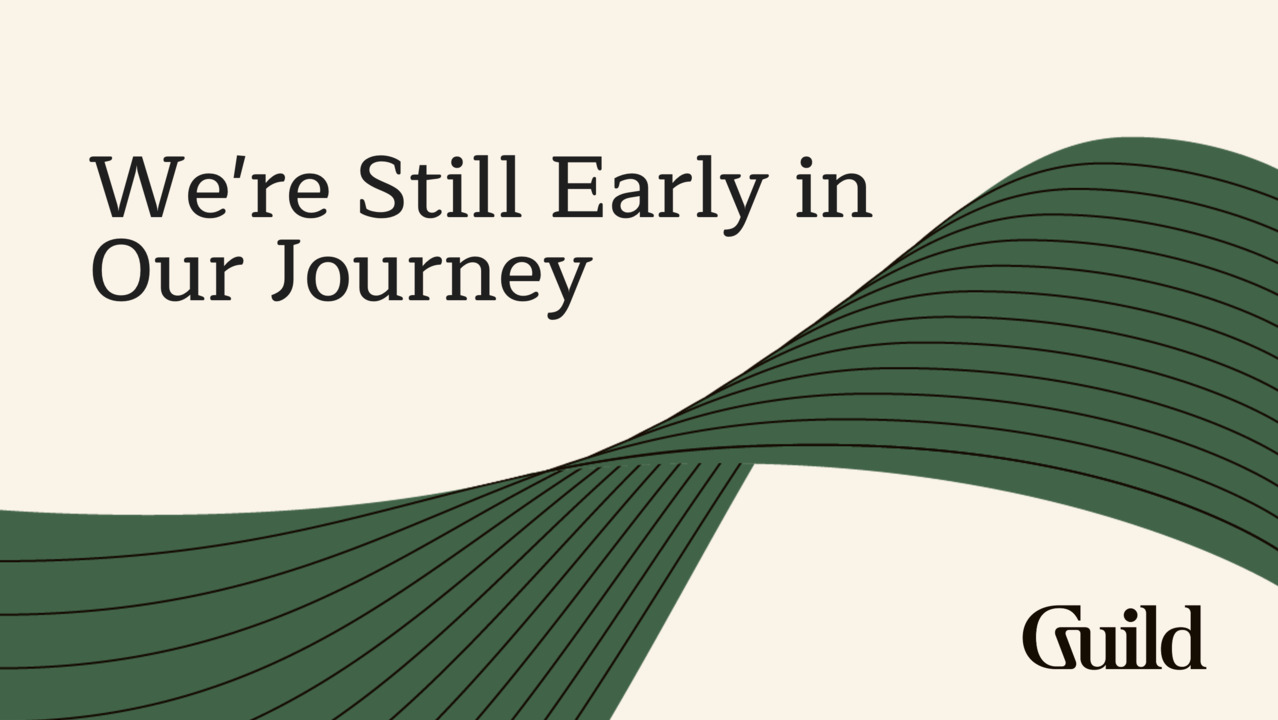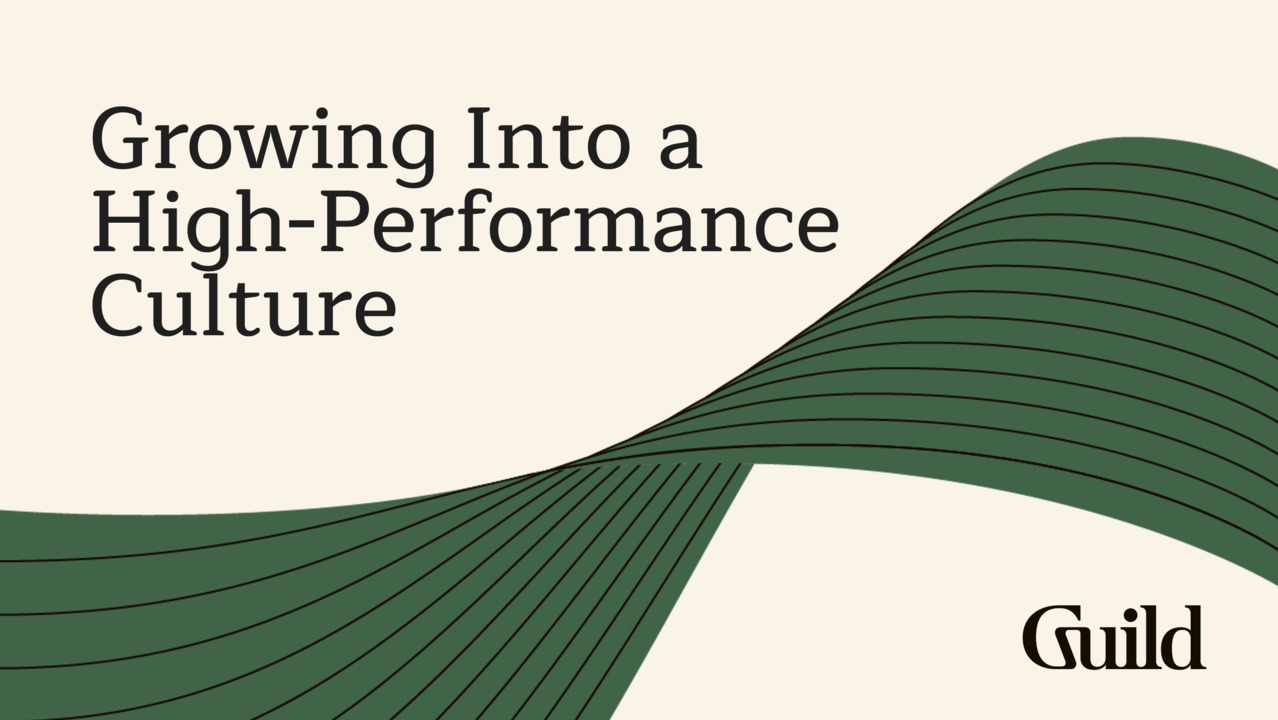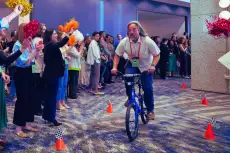"If we tolerate behaviors in any moment—no matter how small—that are not aligned with who we want to be as a group, then we can't grow."
Introduction
There’s an old business saying that goes, “If you’re not growing, you’re dying.”
For others, this might mean achieving growth by any means possible. For us, of course, that’s not the goal. But it’s an important lesson to internalize: driving growth is essential to being able to continue doing our important work. That relentless focus is what’s enabled us to have the impact and success we’ve had so far, and continuing to find ways to grow is how we’ll unlock our next era—and thrive well into the future.
As our leadership outlined at GGL 2025, we're approaching our growth strategy in a way that leverages our past successes and turns them into assets for the future.
First, we're focused on landing new customers. To achieve this, we're diving deeper into our core verticals and exploring promising new ones too.
Second, we’re thinking about expansion. Our bread and butter has always been demonstrating the value we bring to our customers and partners through return on investment (ROI). But now we have new products to offer even more. That includes Guild Global, which presents an opportunity to serve approximately 2 million eligible employees. And Guild Local, which guides employees step-by-step through nearby education and licensure training programs, while helping employers fill critical roles and build stronger local talent pipelines. And it includes crafting collaborative learning experiences just like the Academy you’re in right now.
Last but not least, we're actively thinking about how to use our resources to invest in our future. That means developing new solutions as well as making strategic acquisitions when they make sense. We have a (more than) comfortable amount of cash in the bank, so we're well-positioned to put that money to good use, but we aren’t relying on that to primarily fuel our growth. It’s more a sign that we’re on the right track to keep doing what we do well.
That being said: we’ve come a long way, but we also have a lot of room to grow. That will only happen when all of us understand the role each of us play in driving growth at Guild. This Field Manual takes a look at what that means for each of us and the big plays we’re making as a business to set ourselves up for success now, in our next 10 years, and beyond.
Key Questions Posed by this Field Manual:
What is Guild’s growth vision?
What are the strategic initiatives we are focusing on to drive growth this year?
What is outside-in thinking, and how does it help drive growth?
What are the cultural markers of growth?
Check-in: Driving Growth
Before we continue, take a moment to think about the following questions. Click submit to see what your fellow learners think. Your individual responses will remain anonymous.
1. What percentage of your time (and effort) on a daily basis (on average) do you think is directly related to driving growth for Guild?
2. Do you think we might be overly attached to our own ideas, current products or ways of doing things?
Strategic Priority Spotlight: Drive Growth
Flip through the following slideshow for a reminder of how we’re thinking about what it means to drive growth and which initiatives we’re focusing on this year. If you’d like to publicly comment or ask a question, click the “conversation bubble” icon to start a discussion. The “notepad” icon will allow you to leave yourself a private note only you can see. You can also use the “star” icon to favorite this (or any individual piece of content from this Program).
Idea
Core Concept: Driving Sustainable Customer-Centric Growth
Not all growth is equal. What we’re pursuing is not growth for the sake of growth or at any cost. In this video, Bijal outlines a vision for sustainable growth built on what makes a meaningful impact on customer businesses and learners alike, what she’s hearing in her customer conversations, and what she means by disciplined growth.
Trouble viewing the video? Read the transcript.
Personal Reflection: Your Customer Listening Tour
If you were to go on your own customer listening tour, what do you think you’d hear as it relates to the questions Bijal mentioned she’s been asking on hers? What have you learned from the Customers, prospective customers, our learners & learning partners with whom you’ve interacted or heard about? What is your own sense of where we are?
What's been working well inside of Guild?
Why do you like Guild?
Why does what we do matter?
Where are there areas of opportunity and what do you think we could be doing better?
Where do you think we have opportunities to innovate and continue to grow?
Use the space below to organize your thoughts in any way that’s helpful to you. This is a private reflection—you’ll be the only one who can see it. But if you want to reflect more publicly, you can head over to the Community or use the “comment icon” under the Core Concept or video above.
Core Concept: Outside-In Thinking

Hearing from our customers and learners is critical to developing an outside-in mentality.
Listening to our customers and soliciting their feedback is key to making sure that our success stays aligned with theirs. As Bijal mentions above, we’re not interested in growing at any cost. We are interested in growth that maintains and multiplies the positive impact we have on customers and the learners we all serve. In other words, winning doesn’t matter if it’s not together.
This is easier said than done. How do we ensure that we’re really making decisions that are actually driving growth in this way?
When facing these types of questions, we often start by focusing on what's immediately familiar—our internal processes, metrics, or team goals. While natural, this inside-out perspective can limit our understanding and effectiveness.
Real innovation and sustainable growth come from shifting our viewpoint. Driving success and growth from outside-in means truly understanding the experiences, challenges, and goals of the people we serve. This mindset helps us build solutions based on actual needs, rather than assumptions.
Research consistently shows customer-centric companies outperform their competitors significantly. According to Deloitte, customer-centric businesses are 60% more profitable than companies that do not prioritize customer experience. Additionally, organizations focused on customer needs have higher retention rates, increased customer loyalty, and improved brand reputation.
By genuinely listening to customers (both our buyers, and their employees who we serve as learners), observing their behaviors, and engaging openly with their feedback, we can uncover insights we might otherwise miss. This clarity also helps us see beyond what customers say they want to help us identify the deeper needs driving their actions.
As an idea, outside-in thinking is logical and obvious, but actually developing and maintaining it as a mindset—where the perspective of the customer or the learner is our starting point every day, for every decision—is tough.
Why? Simply because customers (even internal ones) are further away than our own immediate circle. It takes effort to continually put what’s in front of us to the background and bring what’s far away in front of us. And it’s particularly hard for companies that are already successful—like we are—because successful companies tend to fall in love with themselves. We can fall into the trap of thinking that people who don’t buy what we’re selling just need more convincing.
But focusing on our products and what we do best, rather than spending time to deeply understand the evolving needs of our customers and learners, is a long and painful path to growing in the wrong direction.
Challenge: Outside-In Audit
Over the next few days, do a little research for yourself and your team. Try to get a sense of how often you currently engage in outside-in thinking. How often is the perspective of the customer/learner is your starting point every day, for every decision? Come back and tell us what you notice, where you still have room for improvement, and what you are going to do about it.
Share what you find and any changes you are going to make as a result in 560 characters or fewer. After you post, be sure to vote and/or comment on your fellow learners’ responses. Remember, any up votes you receive and any conversations you start will contribute to your position on the Leaderboard.
-
As a member of the people team, y'all are our customers, and I think there are many ways we try to take your perspectives into account - one way I regularly do so is by anchoring ideas and solutions to our culture amp data, the survey responses provide us information on how the organization is doing with specific areas and helps clarify what and how we hope to grow together.
-
The Enterprise Resolution team, which I'm a part of, is a strong example of outside-in thinking in action. We sit at the intersection of multiple teams and advocate for all stakeholders. While we do resolve issues day to day, we attempt to look past the surface issues and identify patterns related to stakeholders' experiences. All of our work is driven by outside-in thinking and we've gained a lot of insight from user experiences.
-
The perspective of the customer comes through in basically everything that I am trying to do in my job. However, I think I (and my team) could be better at using DATA to tell the story about what matters to our customers vs. anecdotes/stories. I think this would be even more powerful in advocating for our customers.
-
I try to start with 'what is our EP / stakeholder trying to achieve... and why?' in pretty much everything I do so that I can represent that within Guild, particularly with our product and member-facing teams... I think it's important to use this outside-in thinking in tandem with our other learner's mindset priority to be able to continue to evolve and innovate most meaningfully in service of our EPs and their people!
-
In the next few weeks, our team will kick off a big learner research study to explicitly gain insights on the short-form, Applied Learning learner experience. Dedicating time for these efforts is crucial to understanding how Guild and our partners can better serve this learner population, and what operational improvements can be made. Eager to determine how soliciting this type of input can become a more regular part of work.
-
One thing I'd love to do is to share insights we get from our conversations with learners, the good, the bad, and the ugly! Because we really do hear it all during our interviews and learners surprise us with their thoughts for improvements.
-
As I've been part of the EPS team for 4 years, I have had the ability to really see our offering, relationship and product from the client perspective. This offers me the opportunity to look at problems from not only the learner perspective, but also the EP perspective.
-
As I've been part of the EPS team for 4 years, I have had the ability to really see our offering, relationship and product from the client perspective. This offers me the opportunity to look at problems from not only the learner perspective, but also the EP perspective.
-
Being mainly focused on the product experience, I've always found it challenging that by and large our 'users' and our 'customers' were two separate groups and they don't always have the same needs. I think it's important that we try to look from both perspectives and identify where they align.
-
All of my customers are internal — people managers, senior leaders, and and members of the people team that often rely on me to help them get their message to people managers. I've seen myself pendulum shift between the customers that I'm listening to. At one point, it was almost all people team members, then it was mostly only managers and senior leaders, and right now I am trying to find a balance/middle ground that allows to incorporate both sustainably. If anyone has any tips for how to implement some checks and balances - let me know! :)
-
My stakeholders/builds are internal but deal with external customers, so there is an interesting balance of ensuring that we're building systems that allow the people that talk to learners are successful. There is a lot of keeping the learner in mind as the end product and making people more productive internally to create that best in class experience for our learners. There are definitely times where we are balancing what is best for the system vs agent productivity vs learner experience and thinking about learner first isn't always best for Guild.
-
My role is predominantly B2B focused marketing, so I most often try to see things from the vantage point of our buyer audience. I see opportunities to more consistently audit both language and messaging to ensure we stay aligned with where our customers are focused. Bringing in learner voices is a compelling way to bridge the gap between our B2B2C motion. Learners cast the dollar vote once that contract is signed; showing their success stories can make meaningful impact tangible to prospects.
-
Guild is a complex place, and it takes time and networks to learn where the pockets of change and influence lie in the organization. While the tailwinds for innovative, customer centric thinking are stronger than ever, Guild should acknowledge that the path to generative ideation and action can be murky. I am seeing really exciting movement on a few dimensions - exploratory platforming for a retail customer, external community impact conversations w/gov model in the tech sector, and other examples where we are aligning value prop to customer interest
Story
Stories from the Field: We’re Still Early in Our Journey
“If you’re not growing, you’re dying.” That’s how we started this Field Manual. But when we talk about growth, what we’re really talking about is change: in a way, growth is simply change oriented in a certain direction. That’s why growth can’t be mindless, and our goal is always to be intentional and strategic with how and where we grow, especially as we face larger questions about what kind of company we are and want to be. In this video, Terrence Cummings, Former Chief Opportunity Officer, shares his frame for understanding these big choices we face and the opportunities that come with them.
Trouble viewing the video? Read the transcript.
Quick Quiz
Take the quiz below to test your understanding. Answer carefully: you can only take the quiz once, and the results will contribute toward your position on the Leaderboard.
Practice
Voices from the Field: Growing Into a High Performance Culture
Part of driving growth is taking on an outside-in mindset, where we put our customers and learners at the center of what we do. But unlocking our next era of growth is also about looking internally at how we operate. That’s not just processes and ways of working. It’s also cultural and interpersonal. In this video, Alana Brandes, Chief People Officer, and Chandler “CK” Koglmeier, Senior Vice President, Product Growth, discuss how they’re thinking about this moment of organizational transformation and the ways that we can promote a culture of high performance from within.
Trouble viewing the video? Read the transcript.
Poll: Our Culture Today
Answer the questions below and then select submit to compare your results to those of your fellow learners. Your answers will remain anonymous.
1. Imagine a cultural spectrum based on the way Alana talks about her experience at Guild through its history. On one end is a culture like “family,” where sometimes people make excuses for bad behavior and have trouble enforcing accountability. On the other end is a culture of high performance, where people routinely hold everyone’s performance to a high standard and routinely call out bad behavior to reinforce shared values. Where do you think Guild currently stands on this spectrum?
Framework: Purpose, Direction, Alignment and Commitment
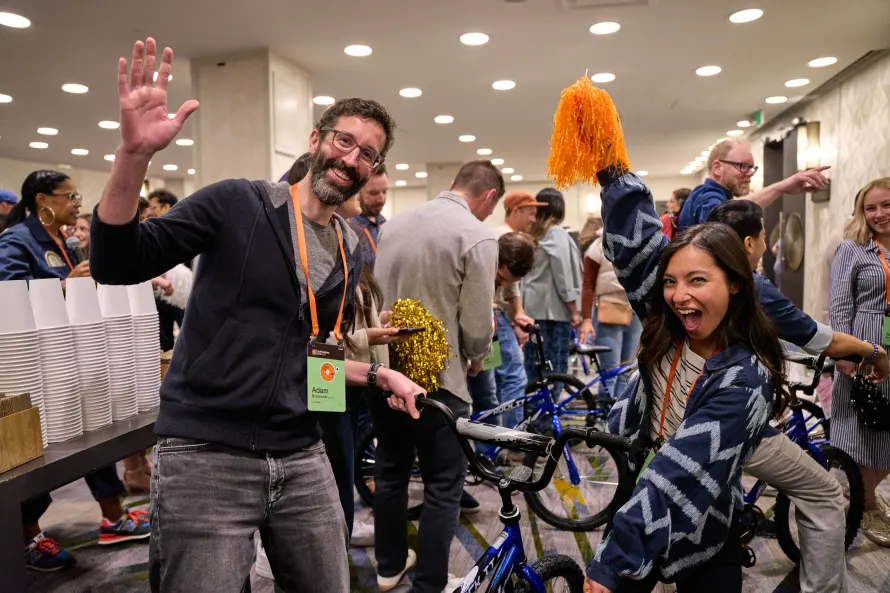
How can purpose, direction, alignment and commitment help us drive growth? Photo Credit: Stephan Werk
Driving the growth we need at the scale of our ambitions is not something we will accomplish individually or even as teams. It will only come from all of us working together and in concert to own and produce collective results. But what are the group dynamics we need to foster to achieve our lofty goals? And what are the signs from inside the organization that will let us know we’re on the right path?
According to the Center for Creative Leadership, three crucial interconnected elements stand out: Direction, Alignment and Commitment. But here at Guild, we’d like to add another: Purpose. These factors don't just stimulate growth—they serve as clear indicators of whether we’re functioning in ways conducive to growth, creating a reinforcing feedback loop. Here’s a little more about what these look like (and where things break down when they’re absent or weak).
Purpose: A strong shared sense of purpose creates a sense of energy, motivation and urgency. It helps tie our daily activities to the deeper, meaningful impact of our work far beyond the financial returns. It can act as a guiding beacon, inspiring each of us, shaping organizational culture, and reinforcing direction, alignment and commitment. All of us may have different parts of our work that feel personally meaningful. But without a shared sense that what we’re doing really matters, organizational resilience, adaptability, innovation and performance will diminish.
Direction: When an organization has clear direction, all members share a common understanding of what success looks like and what they collectively aim to achieve. Weak direction results in ambiguity, diffused efforts, and competing priorities, all of which undermine growth. Conversely, strong direction ensures resources and efforts are consistently focused on strategic objectives, helping us feel like we’re all actually working toward a shared ambition (and actually enabling us to).
Alignment: Weak alignment fragments efforts, leading to inefficiency, redundancy, and overlooked opportunities. Strong alignment ensures that different teams and roles within the business coordinate effectively, making sure we’re capitalizing on individual and team strengths. Workflows are harmonized, efforts complement rather than duplicate each other, and everyone understands how their specific contributions fit into the broader objectives. (Sound familiar? This Program is strongly focused on driving alignment).
Commitment: Low commitment leads to individuals prioritizing personal gains over collective goals, harming group cohesion and impairing long-term growth. Collaboration becomes a means to individual ends, not an intrinsically valued tool for achieving collective success. High levels of commitment reflect an environment where individuals and teams feel deeply responsible for the organization’s success and trust that others feel the same. Members take pride in supporting and relying on each other, particularly in challenging periods.
Though these four elements are often discussed independently, it is important to note that these growth outcomes (and drivers) are interrelated. Efforts to improve one often positively impact the others in the process—and when one area is weak or missing, it can bring down the others too.
Learn More and Go Deeper as a Community
Learn more about CK’s Career Journey in this Resource
Explore the relationship between growth and the decentralization of work in this History Lesson featuring Nick Bloom
Take the conversation beyond only your cohort in Community—sharing the best insights from your team or asking questions to the fuller group
Action
Poll: Driving Growth Through PDAC
Answer the questions below and then select submit to compare your results to those of your fellow learners. Your answers will remain anonymous.
1. Which of the outcomes do you think matters most/will have the biggest impact when it comes to driving growth in the next 1-2 years? (We all agree all are important, but still pick one!)
2. Which of the following do you think your specific team needs to focus on the most in order to drive long-term, sustainable growth?
Debate: Bringing It All Together
In the Story video, Terrence presents a particular viewpoint on Guild and what we need to do to meet the scale of our business ambitions. He mentions cultivating “false scarcity,” an operational culture that prioritizes testing ideas and moving quickly, and the idea that the kind of business we need to be is not the right place for everyone. On the Practice page Alana and CK share what they think we need to do in order to shift into higher performing teams that hold each other accountable and call out bad behaviors in service of growth.
How do you think these ideas might help foster Purpose, Direction, Alignment and Commitment? Where do you see that there might be friction or conflict between them?
Share your thoughts in 700 characters or fewer. After you post, be sure to vote and/or comment (or debate!) on your fellow learners’ responses. Remember, any up votes you receive and any conversations you start will contribute to your position on the Leaderboard.
-
I like the idea that holding ourselves and those we work with accountable to a high standard will allow us to collectively move forward with purpose and direction. This feels like a huge part of Guild's culture today. However, I can imagine if we blindly charge forward without consideration of others, this can lead to conflict and confusion. Maintaining an open channel for positive and constructive feedback feel essential to aid in our alignment and commitment to Guild's mission.
-
Cultivating 'false scarcity' in our coaching practice challenges us to prioritize speedy experimentation and continuous adaptation, ensuring we better meet learners’ evolving needs.
-
False scarcity is important because it helps create a sense of urgency. Every day is Day Zero, and past wins don’t guarantee future success—so we can’t rely solely on previous victories to fuel our next bets.
-
I think that False Scarcity allows us to dig deep and be creative with the resources we have. If you can be efficient and effective during a period of scarcity, you will be tenfold as effective with additional resources.
-
While I believe false scarcity is important, I do think it's crucial to understand when, where, and how we can dip into our resources to drive transformation faster. One example could be temp support and/or contracting work to help up speed up timelines or provide manual support in areas where we need a "scrappy, not crappy" solution until something more scalable is in place.
I also think Guild can change its mind a lot. I think that cascades through the company. I'd love to see us make some big bets / strategic decisions and stick to those more consistently. -
Over the years at Guild, many teams have been faced with the challenge of doing more with less- which feels a lot like scarcity (though perhaps not "false" scarcity), and has increased the need for clear direction and prioritization to drive our desired outcomes to fruition. Our strategic initiatives and focus on high performance recently have further clarified our direction and alignment as an organization- and tying that to changing behaviors and the idea of false scarcity will help us maintain our individual and collective commitment towards serving those goals.
-
Creating urgency through "False Scarcity" helps drive purpose and commitment, especially when big problems affect learners. Our team is good at jumping in and solving fast. But if we do not stop to look back, we might miss chances to get better. Regular retros help us see what worked and what didn’t so we can improve how we solve problems. To be a strong team, we need to move quickly and also take time to learn and grow together.
-
False scarcity can help us move faster together to meet the needs of our customers (i.e., increasing alignment and reducing the amount of time it takes to go back and forth on an idea vs. just going forward!)
-
False scarcity is needed to help us streamline, and think about how we continue to simplify - which at times contradicts how complex our model is. Being able to wade through that using PDAC helps to bring clarity in the messy.
-
False scarcity can influence our sense of purpose and commitment particularly as it grounds everyone in a shared mindset / approach, and ultimately helps shape a culture that is performance driven.
-
The idea of false scarcity directly influences some of the principles of PDAC by helping us determine where to focus our efforts and how to do so effectively. Specifically, a sense of scarcity keeps us aware of the "why" and "how" when we engage in different aspects of work. (Purpose/Direction)
-
False Scarcity can assist in driving Guild Direction. This will assist us in having alignment, as well as if we all have the Direction we want to go towards, we then can align on the approach for each situation/conversation that occurs.
-
False scarcity will help us all think more critically about our direction and what is worth our time and commitment.
-
I think the concept of false scarcity can certainly help us as a company focus in on the Direction principle, by testing out ideas and collectively deciding on what worked, what didn't and how to move forward. I appreciated the conversation Alana and CK shared on shifting away from the "family" mindset and into working as a business team - I believe that mindset can help us align on our culture as a company by demonstrating what behaviors are celebrated and/or not accepted. However, the process of alignment will not come without conflict - but with conflict can come resolution! I believe in the importance of talking out differences as a form of alignment.
-
Having come into Guild from an environment where the scarcity was often not false, I do think that it is a strong driver to get people aligned towards a goal. However I do think that taken too far, it can cause a narrowing of vision where yes, we are all working effectively to just get to where we need to be but never seeing the step beyond.
-
I think the idea of false scarcity is something we should be including in our culture. However, I do think we need to be aware that it not every situation will benefit from the false scarcity approach and we need to be willing/able to take different approaches as needed. Alana and CK's approach to accountability and setting clear expectations feels like a more sustainable takeaway that we could/should implement on a daily basis, especially when approaching decisions from the perspective of false scarcity.
-
False scarcity allows us to focus on what really matters most to drive impact and achieve outcomes, along with the permission to quiet the noise of distractions
-
I appreciate the idea behind false scarcity, but the term doesn't sit well with me, as it feels in the same vein as false urgency, which I have seen as a large contributor to burn-out and shortcutting to hit targets, often resulting in a focus on output instead of outcome. How it is presented here though is how I think of constraints. Some are inherent and some are self-imposed, and effective constraints create focus and directly foster purpose, direction, alignment, and commitment. In that scenario it is easy to tell how you can fit effectively into a team, or if you want to do something else, and accountability and expectations also become clearer.
-
I agree with this sentiment. I usually like to think of this as a balance between operating from a scarcity vs abundance mindset. We can definitely push ourselves under a scarcity mindset, and an abundance mindset may be able to give us a clearer set of goals and pathways to achieving those goals.
-
-
What Alana and CK shared really hits home. Coming from a background where accountability and clear expectations mattered, whether in a project or a team, it makes sense that shifting from a “family” mindset to a performance team helps us to grow. Calling out poor behavior builds trust over time. It also brings Purpose, Direction, and Alignment into focus. Friction might come from those who are not used to directness, but if it’s done for the good of the team, it creates stronger Commitment in the long run.
-
Terrence’s focus on urgency and adaptability fosters Direction and Commitment by encouraging bold action and ownership. Alana and CK’s emphasis on accountability and behavior reinforces Purpose and Alignment, creating trust and shared standards.
-
When done correctly, false scarcity should help us focus on our direction and purpose and be used as an anchor to ensure our limited capacities and resources are aligned to what matters most. It is our responsibility as a team to hold one another accountable that we are spending our time in ways that are most impactful and have enough trust in each other to challenge the status quo and not fall victim to the answer "that's the way it's always been".
-
I think over the past year, we've gotten a lot clearer on direction as a company as well as prioritization (still some room to grow, but I've seen directional gains here). Now that we have that direction, alignment is our next challenge to tackle, which is what I saw Alana and CK speak to. They both spoke to needing to change behavior, which I think is a key part of our alignment, and changing the behavior of 850+ can take time but is also very worth it/much needed.
-
These ideas help give us a clear sense of where we’re going and what matters—building a successful business and making a real impact. They push us to stay focused and scrappy, which helps with alignment and commitment. The “false scarcity” idea keeps us grounded and resourceful.
-
False scarcity is a tough one. We need to move quickly/test ideas, but on the same side of the coin, we have limited resources so why waste time exploring ideas that are not worthwhile. We can likely be more ruthless in how we move forward as a group in a lot of areas. There are definitely groups/process/ideas that are surrounding a specific tool or process that someone "likes" where it becomes amazingly hard to move them from that position. We spend a lot of time on business as usual and I think false scarcity would mean there shouldn't be that much that is "usual". When we pick something that is important we should be invested and committed vs looking for the next shiny thing as well.
-
To me, false scarcity ties directly to alignment; we have lived in versions of Guild where we had 6 tools that all did more of less the same thing; because we didn't want to limit folks or do the work to have the tough conversations on prioritization and alignment. In a world where we can only have one tool, how do we align, how do we have moments of disagreement in service to intentional re-alignment and new direction?
It requires us being clear on what matters and having the trust to say, hey, I see this, how did we get here, and where does it actually make sense for us to go -
A huge part of the point of false scarcity is that it allows space for productive tension. In a culture that values both accountability and belonging, that's a good thing. Limited resources means we can't say yes to all things and that often means we going to have some healthy debate before we get to alignment. In the long run that makes teams crisp on priorities, direction, and what we're going to do to achieve our goals, with the trust that when something isn't working, we as individuals feel both accountable and empowered to speak up.
-
False scarcity is a wonderful forcing mechanism that encourages Guild to pick a direction and align resources towards those goals. It sharpens purpose, and with limited resource alignment, creates commitment so that we're all rowing towards the same objectives. There will always be friction between pursuing objectives, in terms of how we make decisions, stack hands on the stack ranking of importance, and understand operational complexity across the execution tiers of the business. It's making that friction increasingly okay to address that will move us forward.
Poll: Pulse Check
After you've had a chance to fully complete this Field Manual, including engaging in the discussions, please answer the following poll question and then select submit to compare your results to those of your fellow learners. Your individual responses will remain anonymous.
How strongly do you agree or disagree with the statement: “This Field Manual and the discussions within it felt like a valuable use of my time”?
